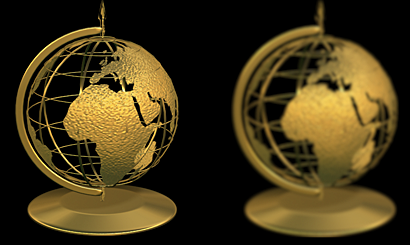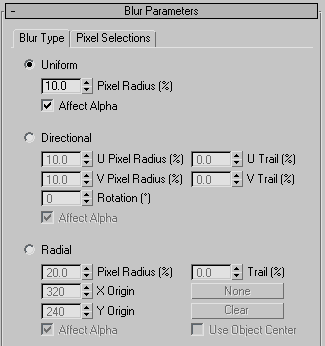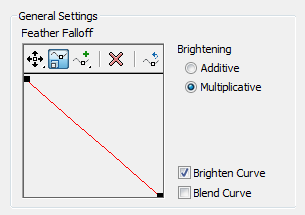The Blur effect allows you to blur your image in three different methods: Uniform, Directional, and Radial. Blur works on individual pixels according to selections made in the Pixel Selections panel. You can blur an entire image, non-background scene elements, by luminance value, or by using a map mask. Blur can give your animation added realism by rendering the illusion of object or camera movement.

Object before and after adding midrange Blur effect.
Interface
Blur Parameters rollout, Blur Type panel

- Uniform Applies the Blur effect evenly across the entire rendered image.
Pixel Radius Determines the intensity of the Blur effect. Increasing the value increases the number of surrounding pixels that each pixel will use to compute its blur. The more pixels used means a greater blur for the image.
Affect Alpha Applies the Uniform Blur effect to the alpha channel when turned on.
- Directional Applies the Blur effect in any direction according to the Directional parameters. The U Pixel Radius and Trail blur the pixels horizontally while the V Pixel Radius and Trail blur the pixels vertically. Rotation is used to rotate the axis of the horizontal and vertical blurring.
U Pixel Radius Determines the horizontal intensity of the Blur effect. Increasing the value increases the number of surrounding pixels that each pixel will use to compute its blur. The more pixels used means a greater horizontal blur for the image.
U Trail Adds “direction” to your blur by weighting more blur to either side of the U axis. This adds a streaking effect and creates the illusion that your objects or your camera are rapidly moving in a particular direction.
V Pixel Radius Determines the vertical intensity of the Blur effect. Increasing the value increases the number of surrounding pixels that each pixel will use to compute its blur, and creates a greater vertical blur for the image.
V Trail Adds “direction” to your blur by weighting more blur to either side of the V axis. This adds a streaking effect and creates the illusion that your objects or your camera are rapidly moving in a particular direction.
Rotation Rotates the axis of the U and V pixels that will be blurred by the U and V Pixel Radius spinners. By using Rotation with the U and V Pixel Radius spinners you can have the Blur effect applied to any direction in your rendered image. When rotation is 0, U corresponds to the image’s X axis and V corresponds to the image’s Y axis.
Affect Alpha Applies the Directional Blur effect to the Alpha channel when turned on.
- Radial Applies the Blur effect radially. Using the Radial parameters you can define a point within your rendered image to use as the center of the Radial Blur. You can use an object as the center or an arbitrary location set by the X and Y Origin spinners. The Blur effect will apply the least amount of blur to the center origin of the effect and gradually increase the blur to the pixels further away from the center. This can be used to simulate motion blur caused by camera zoom.
Pixel Radius Determines the intensity of the Radius Blur effect. Increasing the value increases the number of surrounding pixels that each pixel will use to compute its blur. The more pixels used means a greater blur for the image.
Trail Adds “direction” to your blur by weighting more or less blur toward the center of the Blur effect. This adds a streaking effect and creates the illusion that your objects or your camera are rapidly moving in a particular direction.
X/Y Origin Specifies the center of the blur, in pixels, with respect to the dimensions of the rendered output.
[object button] (Labeled "None" by default.) Lets you specify an object whose center serves as the center of the blur effect. Click this, select an object, and then turn on Use Object Center. The object name appears on the button.
Clear Removes the object name from the button above.
Use Object Center When on, the object specified by the None button (tooltip: Pick an object to center on.) serves as the center of the blur effect. If no object is specified and Use Object Center is on, no blur is added to the rendered image.
Affect Alpha Applies the Radial Blur effect to the Alpha channel when turned on.
Blur Parameters rollout, Pixel Selections panel

- Whole Image
- Affects the entire rendered image when chosen. This is useful when the Blur effect dims your rendered image. By using Brighten and Blend you can maintain the original colors of the scene.
Brighten Brightens the entire image.
Blend Blends the Blur effect and the Whole Image parameters with the original rendered image. This can be used to create a soft-focus effect.
- Non-Background
- Affects everything but the background image or animation when chosen. This is useful when the Blur effect has dimmed your scene objects but not the background. By Using Brighten, Blend, and Feather Radius, you can maintain the original colors of the scene.
Brighten Brightens the rendered image except for the background image or animation.
Blend Blends the Blur effect and the Non-Background parameters with the original rendered image.
Feather Radius Feathers the Blur effect applied to the Non-Background elements of your scene. When using Non-Background as a Pixel Selection you will notice that the scene objects have a hard edge to their blur since the objects are being blurred but the background is not. Use the spinner to feather the blur and eliminate the hard edge of the effect.
- Luminance
- Affects any pixels that have luminance values that fall between it’s Min and Max spinners.
Brighten Brightens pixels that fall between the Minimum and Maximum luminance values.
Blend Blends the Blur effect and the Luminance parameters with the original rendered image.
Min Sets the minimum luminance value necessary for each pixel in order for the Blur effect to be applied to the pixel.
Max Sets the maximum luminance value a pixel can have in order for the Blur effect to be applied to the pixel.
Feather Radius Feathers the Blur effect applied to pixels that fall between the Minimum and Maximum luminance values. When using Luminance as a Pixel Selection the Blur effect can create a hard edge on the effect. Use the spinner to feather the blur and eliminate the hard edge of the effect.
- Map Mask
- Applies the Blur effect according to the channel selected and mask applied through the Material/Map Browser. After selecting a mask you must select a channel from the Channel list. Blur then examines the mask and channel according to the values set in the Minimum and Maximum spinners. Any pixels in the mask that are of the selected channel and between the Min and Max values will have the Blur effect applied. This is useful for blurring selected portions of a scene such as a winter morning as seen through a frost covered window.
[map button] (Labeled "None" by default.) Click to assign a bitmap or map from the Material/Map Browser. After you choose a bitmap or map, this button displays the map's name.
You can also drag and drop a map from a Material Editor sample slot. If the Slate Material Editor is open, you can drag from a map node's output socket, then drop onto this button. You can also drag and drop from a map button in the Material Editor or anywhere else in the 3ds Max interface. When you drop a map onto the displacement map button, a dialog asks if you want the map to be a copy (independent) or an instance of the source map.
To adjust the displacement map's parameters (for example, to assign a bitmap or change the coordinate settings), drag the Map button to the Material Editor, and be sure to drop it as an instance. In the Compact Material Editor, drop the map over an unused sample slot. In the Slate Material Editor, drop it over the active View.
Chan[nel] drop-down list Selects a channel that the Blur effect will be applied to. After selecting a particular channel, use the minimum and maximum spinners to determine the value a mask pixel must have in order to have the effect applied to it.
Brighten Brightens the portions of the image that the Blur effect is applied to.
Blend Blends the Map Mask Blur effect with the original rendered image.
Min The minimum value (RGB, Alpha, or Luminance) a pixel must have in order to have the Blur effect applied to it.
Max The maximum value (RGB, Alpha, or Luminance) a pixel can have for the Blur effect to be applied to it.
Feather Radius Feathers the Blur effect applied to pixels that fall between the Minimum and Maximum channel values. When using map mask as a Pixel Selection, the Blur effect can create a hard edge on the effect. Use the spinner to feather the blur and eliminate the hard edge of the effect.
- Object ID
- Applies the Blur effect to an object or part of an object with a specific Object ID (in the G-Buffer), if the object matches the Filter settings. To add or replace an Object ID, use the spinners or enter a value in the ID text box and then click the appropriate button.
Min Lum The minimum luminance value a pixel must have in order to have the Blur effect applied to it.
Max Lum The maximum luminance value a pixel can have for the Blur effect to be applied to it.
Brighten Brightens the portion of the image that the Blur effect is applied to.
Blend Blends the Object ID Blur effect with the original rendered image.
F[eather] Radius Feathers the Blur effect applied to pixels that fall between the Minimum and Maximum luminance values. When using Luminance as a Pixel Selection, the Blur effect can create a hard edge on the effect. Use the spinner to feather the blur and eliminate the hard edge of the effect.
- Material ID
- Applies the Blur effect to a material or part of a material with a specific Material ID Channel, if the material matches the Filter settings. To add or replace a Material ID channel, use the spinners or enter a value in the ID text box and then click the appropriate button.
Min Lum The minimum luminance value a pixel must have in order to have the Blur effect applied to it.
Max Lum The maximum luminance value a pixel can have for the Blur effect to be applied to it.
Brighten Brightens the portion of the image that the Blur effect is applied to.
Blend Blends the Material Blur effect with the original rendered image.
F[eather] Radius Feathers the Blur effect applied to pixels that fall between the Minimum and Maximum luminance values. When using Luminance as a Pixel Selection, the Blur effect can create a hard edge on the effect. Use the spinner to feather the blur and eliminate the hard edge of the effect.
General Settings group

- Feather Falloff control curve
- The Feather falloff curve allows you to determine the feather falloff off the Blur effect based on a graph. You can add points to the graph to create a falloff curve, and adjust the interpolation in those points.
 Move Lets you move the points on the graph. This button is a flyout, providing
Move Lets you move the points on the graph. This button is a flyout, providing  free movement (the default),
free movement (the default),  horizontal, and
horizontal, and  vertical movement.
vertical movement.  Scale Point Lets you scale the points on the graph. This moves each selected point vertically, in proportion to its previous value. Click a point to scale, or draw a selection rectangle around several contiguous points to select them, and then drag any point in the selection to scale them all.
Scale Point Lets you scale the points on the graph. This moves each selected point vertically, in proportion to its previous value. Click a point to scale, or draw a selection rectangle around several contiguous points to select them, and then drag any point in the selection to scale them all.  Add Point Lets you create additional points on the falloff curve. This button is a flyout, providing
Add Point Lets you create additional points on the falloff curve. This button is a flyout, providing  linear points (the default) and
linear points (the default) and  Bezier points with handles.
Bezier points with handles.  Delete Point Removes points from the graph.
Delete Point Removes points from the graph.  Reset Curves Returns graph to its default, a straight line between 0,0 and 1,1.
Reset Curves Returns graph to its default, a straight line between 0,0 and 1,1. - Brightening
- These radio buttons let you select additive or multiplicative brightening. Additive brightening is brighter and more distinct than multiplicative brightening. Additive brightening is useful when you use blur in combination with a Glow effect. Multiplicative brightening provides a soft highlight to the Blur effect.
- Brighten Curve
- Lets you edit the brightening curve in the Feather Falloff curve graph.
- Blend Curve
- Lets you edit the blend curve in the Feather Falloff curve graph.